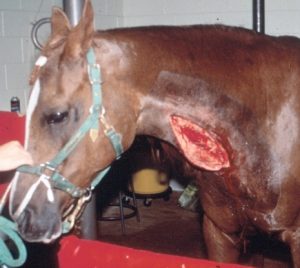Equine Oral, Esophageal and Rectal disorders
Esophageal perforation
Esophageal perforation can occur due to external trauma (kick) or internal trauma (esophageal foreign body). Clinical signs can include severe edema, cellulitis, emphysema, fever, and dyspnea.

The horse may need a tracheotomy due to swelling that compresses that trachea. The infection can descend into the mediastinal tissues; horses may develop pneumomediastinum and/or pneumothorax.
If the wound is acute (within 12h), it should be closed primarily if possible. If the wound is older than 12h or if it can’t be closed,
ventral drainage is essential while the wound heals by second intention.

Horses should be treated with antibiotics, antiinflammatory drugs, and given tetanus toxoid. An indwelling feeding tube (through nostril or wound) is used for 10 days.
Resources
Treatment of cervical oesophageal rupture in horses, EVE 2013, Vol.25(9), pp.456-460
Management and complications associated with treatment of cervical oesophageal perforations in horses, EVE 2013 Vol.25(5), pp.247-255
disseminated infection under the skin

